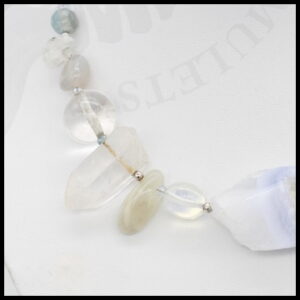01.04.22 The official birthstone for April is diamond which can be incredibly expensive depending on the quality of the five Cs: colour, cut, clarity, carat and certification. I will write here about diamonds although it is not generally a stone I work with and, currently, there are no products listed containing diamonds.
 Clear quartz and manmade Cubic Zirconia (CZ) are very affordable and acceptable alternatives to diamond for anyone who’s on a tight budget and I’ll point you towards those products at the end of the article. Mid-range alternatives to diamond include white topaz or white sapphire.
Clear quartz and manmade Cubic Zirconia (CZ) are very affordable and acceptable alternatives to diamond for anyone who’s on a tight budget and I’ll point you towards those products at the end of the article. Mid-range alternatives to diamond include white topaz or white sapphire.
So, why are diamonds so expensive? Well, like many things, it’s a case of supply and demand. There’s a limited supply of these gemstones, especially the rare colours, it costs a lot to transform them from lumps of stone to beautiful, marketable gems and lots of people are keen to buy the small numbers available. This niche market has been artificially created to a certain extent. In the 1800s an abundant source of diamonds was discovered in Kimberly, South Africa, so huge it had the potential to flood the market and devalue this gemstone which, until then, had been the preserve of the privileged and the wealthy. De Beers bought up this mine and controlled the release of these diamonds into the market thus retaining their high status and value. At one point De Beers controlled 85% of the diamond market although this has dropped to around 40% today.
The provenance of these valued gems is a concern for many buyers. Traditionally diamonds were mined in war zones such as South Africa, Angola and Sierra Leone, with their sale often funding insurgency or a warlord’s activity. The “price” of diamonds has been far greater than their monetary value and this is where the terms “blood diamond” and “conflict diamond” come from. Thankfully it has become far easier to source conflict-free diamonds following stricter regulations and commitment from the diamond supply industry. It is thought only around 5% of all diamonds constitute blood diamonds today and most suppliers are keen to provide evidence that their gems are ethically sourced.
Mines have opened up in Russia, Canada and Australia and practically identical synthetic (lab created) diamonds are also now available although, of course, this should always be made clear to a buyer.
 So, let’s have a quick look at lovely clear quartz which is also called rock crystal. It’s a form of silica and is the most common mineral in the earth’s crust. Clear quartz is known as “the master healer” or a “one size fits all” gemstone, the mother of all crystals, since it amplifies the healing energies of other crystals. It fortifies and strengthens all systems of the body and also improves mental and physical energy, stamina and strength. Incredibly affordable, it’s a brilliant all-rounder to have in your collection.
So, let’s have a quick look at lovely clear quartz which is also called rock crystal. It’s a form of silica and is the most common mineral in the earth’s crust. Clear quartz is known as “the master healer” or a “one size fits all” gemstone, the mother of all crystals, since it amplifies the healing energies of other crystals. It fortifies and strengthens all systems of the body and also improves mental and physical energy, stamina and strength. Incredibly affordable, it’s a brilliant all-rounder to have in your collection.
Although cubic zirconia is seen as an alternative to the very expensive diamond, it has virtually no value, since it’s created in a lab. They do, however, tend to be flawless and there’s absolutely nothing wrong with choosing CZ as a “cheap and cheerful” option if you fancy a bit of sparkle in your life. I don’t use CZ myself but some of the popular smaller items I’ve sold since the days of Artemis and The Mermaid do contain CZ. This is always described clearly in the description.
So, there is the main birthstone for April and its alternatives. Jewellery and other items with clear quartz can be viewed HERE whilst cubic zirconia (CZ) can be seen HERE.